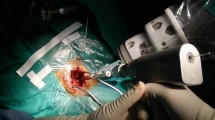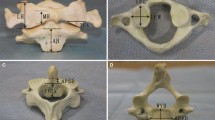Abstract
Introduction: Atlantoaxial instabilities, which require surgical fixation follow a variety of clinical disorders. Different surgical procedures are used for stabilization of the atlantoaxial complex, mainly posterior wiring techniques and transarticular screw fixation. Nowadays, often a combination of transarticular screws and a posterior one-point fixation is used to achieve a three-point fixation, with superior biomechanical stability and good clinical results. Different modifications were developed to improve this technique. In 1995, a percutaneous approach for atlantoaxial stabilization was introduced. In clinical studies, the technique showed a tendency towards better outcome. Beside the outcome, the intraoperative performance is of special interest for minimal invasive approaches. We therefore compared the operation time, screw angulation and blood loss, between the open and percutaneous posterior atlantoaxial techniques. Materials and methods: Two groups, each consisting of 17 patients, with either open (group 1) or percutaneous (group 2) atlantoxial stabilization, were compared. The operation time was retrospectively acquired from the patient’s charts. The data for blood loss was provided by our anaesthesiological department, separated for intraoperative, postoperative and total blood loss. Screw angulation was measured on the postoperative x-ray by an orthopaedic surgeon. Results: The percutaneous group showed an average intraoperative blood loss of 239.7 ml, compared to 929.4 ml for the open group (p≤0.001). The analogue values for the postoperative blood loss were 142.9 ml and 379.4 ml for group 2 and group 1, respectively (p=0.008). Consecutively, the total blood loss showed also a statistically significant difference (p≤0.001). The operation time was significantly different (p≤0.001), with average values of 175.3 min (group 1) and 110.6 min (group 2). Screw angulation showed a trend towards a steeper angulation in the percutaneous group with an average angle of 56.8°, compared to 53.9° (group 1), although this was not statistically significant (p=0.053). Conclusion: The percutaneous technique for atlantoaxial stabilization with a three-point fixation has clear intraoperative benefits, with shorter operation time and reduced blood loss. A trend towards steeper screw angulation was found and shows at least equal feasibility for transarticular screw placement with the percutaneous technique, compared to the standard open approach.



Similar content being viewed by others
References
Anderson LD, D’Alonzo RT (1974) Fractures of the odontoid process of the axis. J Bone Joint Surg [Am] 56:1663–1674
Blauth M, Richter M, Lange U (1999) Transarticular screw fixation C1/2 in traumatic atlantoaxial instabilities. Comparison between percutaneous and open procedures. Orthopäde 28:651–661
Brooks AL, Jenkins EB (1978) Atlanto-axial arthrodesis by the wedge compression method. J Bone Joint Surg 60-A:279–284
Dickman CA, Foley KT, Sonntag VK, Smith MM (1995) Cannulated screws for odontoid screw fixation and atlantoaxial transarticular screw fixation. Technical note. J Neurosurg 83:1095–1100
Dickman CA, Sonntag VK, Papadopoulos SM, Hadley MN (1991) The interspinous method of posterior atlantoaxial arthrodesis. J Neurosurg 74:190–198
Farey ID, Nadkarni S, Smith N (1999) Modified Gallie technique versus transarticular screw fixation in C1-C2 fusion. Clin Orthop 359:126–135
Fidler MW, Valentine NW, Rahmatalla AT (1994) Posterior atlantoaxial fusion A new internal fixation device. Spine 19:1397–1401
Fraser AB, Sen C, Casden AM, Catalano PJ, Post KD (1994) Cervical transdural intramedullary migration of a sublaminar wire. A complication of cervical fixation. Spine 19:456–459
Grob D, Jeanneret B, Aebi M, Markwalder TM (1991) Atlanto-axial fusion with transarticular screw fixation. J Bone Joint Surg 73-B:972–976
Haegner U, Handrock M, Schade H (2002) "Ultrasound tonsillectomy" in comparison with conventional tonsillectomy. HNO 50:836–843
Hanson PB, Montesano PX, Sharkey NA, Rausching W (1991) Anatomic and biomechanical assessment of transarticular screw fixation for atlantoaxial instability. Spine 16:1141–1145
Henriques T, Cunningham BW, Olerud C, Shimamoto N, Lee GA, Larsson S and McAfee PA (2000) Biomechanical comparison of five different atlantoaxial posterior fixation techniques. Spine 25:2877–2883
Lundy DW, Murray HH (1997) Neurological deterioration after posterior wiring of the cervical spine. J Bone Joint Surg Br 79:948–951
Magerl F, Seemann PS (1987) Stable posterior fusion of the atlas and axis by transarticular screw fixation. In: Kehr P, Weidner A (eds) Cervical spine I. Springer, Wien, pp 322–327
McGraw RW, Rusch RM (1973) Atlanto-axial arthrodesis. J Bone Joint Surg [Br] 55:482–489
McGuire RA, Harkey HL (1995) Modification of technique and results of atlantoaxial transfacet stabilization. Orthopedics 18:1029–1032
Mimatsu K, Katoh F, Kawakami N, Nakagami W (1992) Atlantoaxial fusion with posterior double wire fixation. Spine 17:1409–1413
Montesano PX, Juach EC, Anderson PA, Benson DR, Hanson PB (1991) Biomechanics of cervical spine internal fixation. Spine 16:S10–S16
Naderi S, Crawford NR, Song GS, Sonntag VK, Dickman CA (1998) Biomechanical comparison of C1-C2 posterior fixations. Cable, graft, and screw combinations. Spine 23:1946–55; discussion 1955–6
Richter M, Schmidt R, Claes L, Puhl W, Wilke H-J (2002) Posterior atlantoaxial fixation: biomechanical in vitro comparison of six different techniques. Spine 27:1724–1732
Rodrigues FA, Hodgson BF, Craig JB (1991) Posterior atlantoaxial arthrodesis A simplified method. Spine 16:878–880
Salmon JH (1977) Fractures of the second cervical vertebra: internal fixation by interlaminar wiring. Neurosurgery 1:125–127
Smith MD, Kotzar G, Yoo J, Bohlmann H (1993) A biomechanical analysis of atlanto-axial stabilization methods using a bovine model. C1/2 fixation analysis. Clin Orthop 290:285–295
Smith MD, Phillips WA, Hensinger RN (1991) Complications of fusion to the upper cervical spine. Spine 16:702–705
Stillerman CB, Wilson JA (1993) Atlanto-axial stabilization with posterior transarticular screw fixation: technical description and report of 22 cases. Neurosurgery 32:948–954
Walker RA, Syed ZA (2001) Harmonic scalpel tonsillectomy versus electrocautery tonsillectomy: a comparative pilot study. Otolaryngol Head Neck Surg 125:449–455
Wilke H-J, Fischer K, Kugler A, Magerl F, Claes L, Wörsdorfer O (1992) In vitro investigations of internal fixation systems of the upper cervical spine II. Stability of posterior atlanto-axial fixation techniques. Eur Spine J 1:191–199
Willging JP, Wiatrak BJ (2003) Harmonic scalpel tonsillectomy in children: a randomized prospective study. Otolaryngol Head Neck Surg 128:318–325
Author information
Authors and Affiliations
Corresponding author
Rights and permissions
About this article
Cite this article
Schmidt, R., Richter, M., Gleichsner, F. et al. Posterior atlantoaxial three-point fixation: comparison of intraoperative performance between open and percutaneous techniques. Arch Orthop Trauma Surg 126, 150–156 (2006). https://doi.org/10.1007/s00402-005-0046-9
Received:
Published:
Issue Date:
DOI: https://doi.org/10.1007/s00402-005-0046-9




